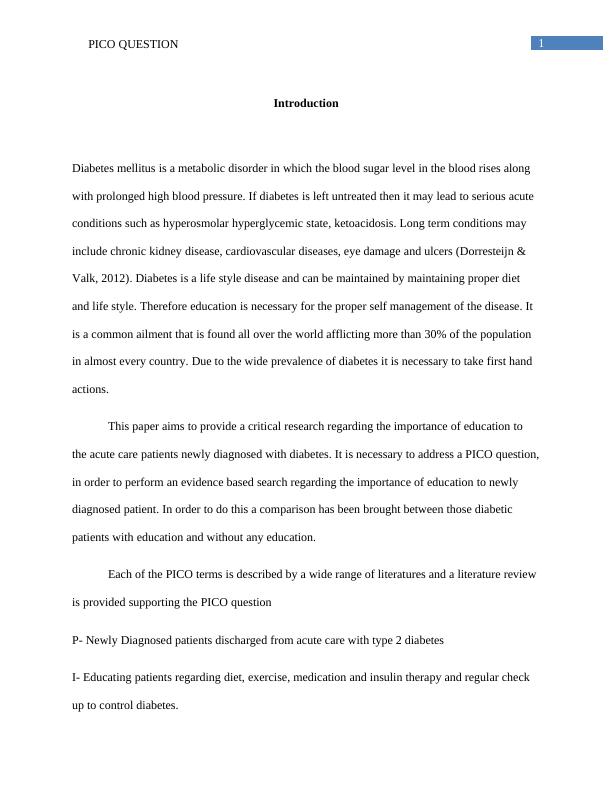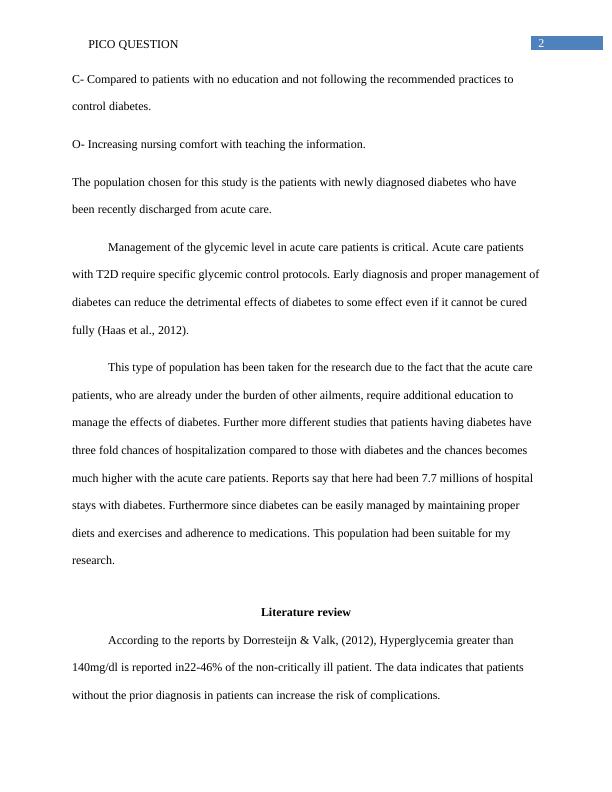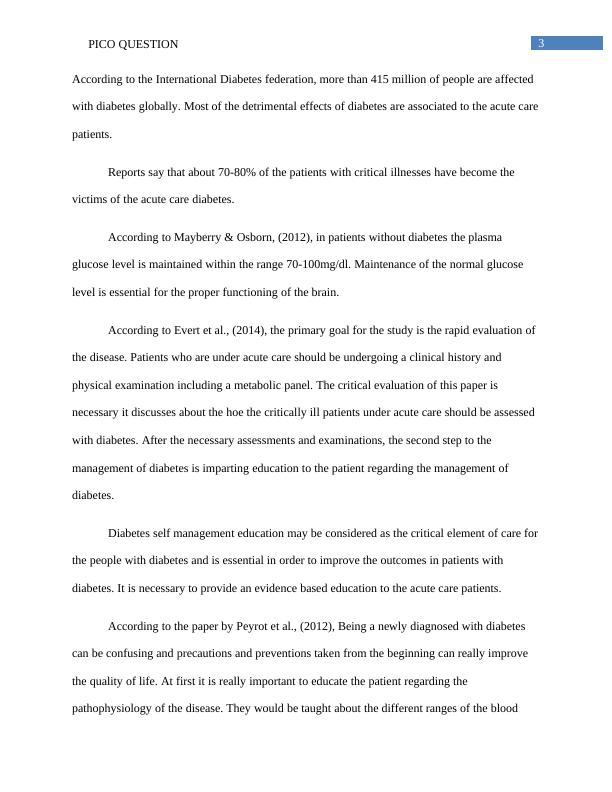Diagnosis and Classification of Diabetes Mellitus
Added on 2020-04-21
12 Pages3298 Words177 Views
Running head: PICO QUESTIONPICO QUESTION ON PATIENT WITH NEWLY DIAGNOSED T2DName of the StudentName of the universityAuthor’s note

1PICO QUESTIONIntroductionDiabetes mellitus is a metabolic disorder in which the blood sugar level in the blood rises along with prolonged high blood pressure. If diabetes is left untreated then it may lead to serious acute conditions such as hyperosmolar hyperglycemic state, ketoacidosis. Long term conditions may include chronic kidney disease, cardiovascular diseases, eye damage and ulcers (Dorresteijn & Valk, 2012). Diabetes is a life style disease and can be maintained by maintaining proper diet and life style. Therefore education is necessary for the proper self management of the disease. It is a common ailment that is found all over the world afflicting more than 30% of the population in almost every country. Due to the wide prevalence of diabetes it is necessary to take first hand actions. This paper aims to provide a critical research regarding the importance of education to the acute care patients newly diagnosed with diabetes. It is necessary to address a PICO question,in order to perform an evidence based search regarding the importance of education to newly diagnosed patient. In order to do this a comparison has been brought between those diabetic patients with education and without any education.Each of the PICO terms is described by a wide range of literatures and a literature review is provided supporting the PICO questionP- Newly Diagnosed patientsdischarged from acute care with type 2 diabetesI- Educating patients regarding diet, exercise, medication and insulin therapy and regular check up to control diabetes.

2PICO QUESTIONC- Compared to patients with no education and not following the recommended practices to control diabetes.O- Increasing nursing comfort with teaching the information.The population chosen for this study is the patients with newly diagnosed diabetes who have been recently discharged from acute care. Management of the glycemic level in acute care patients is critical. Acute care patients with T2D require specific glycemic control protocols. Early diagnosis and proper management ofdiabetes can reduce the detrimental effects of diabetes to some effect even if it cannot be cured fully (Haas et al., 2012).This type of population has been taken for the research due to the fact that the acute care patients, who are already under the burden of other ailments, require additional education to manage the effects of diabetes. Further more different studies that patients having diabetes have three fold chances of hospitalization compared to those with diabetes and the chances becomes much higher with the acute care patients. Reports say that here had been 7.7 millions of hospital stays with diabetes. Furthermore since diabetes can be easily managed by maintaining proper diets and exercises and adherence to medications. This population had been suitable for my research.Literature reviewAccording to the reports by Dorresteijn & Valk, (2012), Hyperglycemia greater than 140mg/dl is reported in22-46% of the non-critically ill patient. The data indicates that patients without the prior diagnosis in patients can increase the risk of complications.

3PICO QUESTIONAccording to the International Diabetes federation, more than 415 million of people are affected with diabetes globally. Most of the detrimental effects of diabetes are associated to the acute carepatients. Reports say that about 70-80% of the patients with critical illnesses have become the victims of the acute care diabetes. According to Mayberry & Osborn, (2012), in patients without diabetes the plasma glucose level is maintained within the range 70-100mg/dl. Maintenance of the normal glucose level is essential for the proper functioning of the brain.According to Evert et al., (2014), the primary goal for the study is the rapid evaluation of the disease. Patients who are under acute care should be undergoing a clinical history and physical examination including a metabolic panel. The critical evaluation of this paper is necessary it discusses about the hoe the critically ill patients under acute care should be assessed with diabetes. After the necessary assessments and examinations, the second step to the management of diabetes is imparting education to the patient regarding the management of diabetes. Diabetes self management education may be considered as the critical element of care forthe people with diabetes and is essential in order to improve the outcomes in patients with diabetes. It is necessary to provide an evidence based education to the acute care patients. According to the paper by Peyrot et al., (2012), Being a newly diagnosed with diabetes can be confusing and precautions and preventions taken from the beginning can really improve the quality of life. At first it is really important to educate the patient regarding the pathophysiology of the disease. They would be taught about the different ranges of the blood

End of preview
Want to access all the pages? Upload your documents or become a member.
Related Documents
Awareness and Education in Diabetes Type 2 Affected Peoplelg...
|4
|925
|270
Regular Exercise for Management of Type 2 Diabetes: A Scoping Reviewlg...
|2
|1263
|175
Management of Diabetes Mellituslg...
|11
|3138
|127
Evidence Based Practice On Diabetes Name of the Student Name of the University Author's Notelg...
|10
|2337
|67
Annotated Bibliography on Non-Pharmacological Intervention for Type 2 Diabetes Mellituslg...
|12
|3513
|108
Identify a cardiac or respiratory issuelg...
|3
|852
|19
